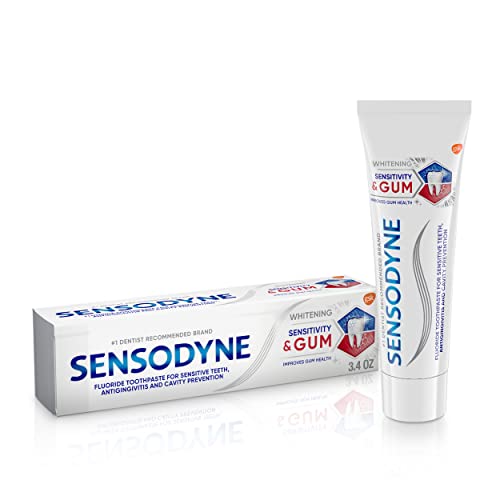Have you ever experienced that sharp, shooting pain when you bite into something cold or hot? It’s not a pleasant sensation, and we understand how frustrating and uncomfortable it can be. That’s why we’re here to delve into the topic of tooth sensitivity and its potential connection to gum disease. We know how important it is to have a healthy and pain-free smile, so let’s uncover the truth behind this common dental concern together.
Relief for Sensitive Teeth: The Top-Selling Toothpastes for Tooth Sensitivity
Causes and Symptoms of Tooth Sensitivity
Tooth sensitivity is a common dental issue that affects millions of people worldwide. It can cause discomfort and pain, making it difficult to enjoy certain foods and drinks. In this blog section, we will explore the various causes of tooth sensitivity and discuss the common symptoms associated with it.
Causes of Tooth Sensitivity
- Enamel erosion: The outer layer of your teeth, known as enamel, protects the underlying dentin. When the enamel becomes worn down or eroded, the dentin becomes exposed, leading to tooth sensitivity. Common causes of enamel erosion include:
- Acidic foods and drinks: Consuming excessive amounts of acidic foods and beverages, such as citrus fruits, soda, and wine, can erode the enamel over time.
- Tooth grinding: Habitual teeth grinding, also known as bruxism, can wear down the enamel and expose the dentin.
- Gastroesophageal reflux disease (GERD): Acid reflux can introduce stomach acid into the mouth, which can erode the enamel.
- Gum recession: The gums act as a protective barrier for the tooth roots. When the gum tissue recedes, the roots become exposed, making them sensitive to hot and cold temperatures. Causes of gum recession include:
- Brushing too hard: Aggressive brushing can cause the gums to recede and expose the sensitive roots.
- Gum disease: Periodontal disease, characterized by bacterial infection and inflammation of the gums, can lead to gum recession if left untreated.
- Aging: As we age, our gums naturally recede, exposing the sensitive roots.
- Tooth decay: Cavities or tooth decay can cause tooth sensitivity, particularly when the decay reaches the inner layers of the tooth. The bacteria in plaque produce acids that can erode the enamel and lead to decay.
Symptoms of Tooth Sensitivity
- Sharp pain when consuming hot or cold food and drinks: One of the most common symptoms of tooth sensitivity is a sharp, sudden pain that occurs when you eat or drink something hot or cold.
- Discomfort when brushing or flossing: People with sensitive teeth may experience discomfort or pain while brushing or flossing, especially if they brush too vigorously or use a hard-bristled toothbrush.
- Sensitivity to sweet or acidic foods: Tooth sensitivity can also cause discomfort when consuming sweet or acidic foods, as these can exacerbate the sensitivity.
- Pain when exposed to cold air: In some cases, individuals with tooth sensitivity may experience pain or discomfort when breathing in cold air, such as when they step outside on a chilly day.
It is important to note that tooth sensitivity can vary in severity from person to person. Some individuals may only experience mild discomfort, while others may have intense pain. If you are experiencing tooth sensitivity, it is advisable to consult with a dentist to determine the underlying cause and receive appropriate treatment.
Remember, early intervention and proper dental care can help alleviate tooth sensitivity and restore your ability to enjoy your favorite foods and beverages without pain or discomfort.
Understanding Gum Disease
Gum disease, also known as periodontal disease, is a common oral health issue that affects millions of people worldwide. It is a progressive condition that can lead to serious dental problems if left untreated. In this blog section, we will provide a comprehensive overview of gum disease, its stages, effects, risk factors, and common signs. By understanding gum disease, you can take proactive measures to maintain a healthy smile.
What is Gum Disease?
Gum disease refers to an infection of the gums and supporting structures of the teeth. It is primarily caused by the buildup of plaque, a sticky film of bacteria that forms on the teeth. When plaque is not properly removed through regular brushing and flossing, it can harden into tartar, which can only be removed by a professional dental cleaning.
Stages of Gum Disease
Gum disease progresses in stages, each with its own set of symptoms and potential damage. These stages include:
- Gingivitis: This is the earliest stage of gum disease and is characterized by inflamed, red, and swollen gums. Gingivitis is reversible with proper oral hygiene and professional dental care.
- Periodontitis: If left untreated, gingivitis can progress to periodontitis. At this stage, the infection spreads below the gum line, causing the gums to recede and form pockets. This allows bacteria to penetrate deeper, leading to bone and tissue damage.
- Advanced Periodontitis: In the final stage, the supporting structures of the teeth, including bone and ligaments, are severely damaged. Teeth may become loose or even fall out due to the destruction of the surrounding tissues.
Effects of Gum Disease
Gum disease can have various detrimental effects on oral health, including:
- Tooth Loss: As gum disease progresses, the supporting structures of the teeth weaken, leading to tooth loss.
- Bad Breath: The bacteria associated with gum disease can cause persistent bad breath that is difficult to eliminate.
- Receding Gums: As the gums recede, the roots of the teeth become exposed, making them more susceptible to decay and sensitivity.
- Bone Loss: Advanced gum disease can result in significant bone loss, which can ultimately affect the overall structure and stability of the jaw.
Risk Factors for Gum Disease
Certain factors can increase the likelihood of developing gum disease. These include:
- Poor Oral Hygiene: Inadequate brushing and flossing habits can allow plaque to accumulate, leading to gum disease.
- Tobacco Use: Smoking or chewing tobacco can significantly increase the risk of gum disease.
- Genetics: Some individuals may be genetically predisposed to gum disease, making them more susceptible to its development.
- Hormonal Changes: Hormonal fluctuations during puberty, pregnancy, and menopause can make gums more sensitive and prone to inflammation.
- Chronic Illnesses: Certain medical conditions, such as diabetes and HIV/AIDS, can impair the body’s immune system, making it harder to fight off infections like gum disease.
Common Signs of Gum Disease
Recognizing the signs of gum disease is crucial for early intervention and treatment. Keep an eye out for these indicators:
- Bleeding Gums: Gums that bleed easily, especially during brushing or flossing, can be a sign of gum disease.
- Swollen or Red Gums: Inflamed gums that appear red or swollen may indicate the presence of an infection.
- Receding Gums: If your teeth appear longer or you notice exposed tooth roots, it may be an indication of gum recession.
- Persistent Bad Breath: Chronic bad breath that persists even after brushing and using mouthwash can be a symptom of gum disease.
- Sensitive Teeth: Increased tooth sensitivity to hot, cold, or sweet stimuli can be a result of gum recession and exposed tooth roots.
By understanding the stages, effects, risk factors, and signs of gum disease, you are empowered to take proactive steps to protect your oral health. Regular dental check-ups, proper oral hygiene, and a healthy lifestyle can help prevent gum disease and ensure a vibrant smile for years to come.
The Relationship between Tooth Sensitivity and Gum Disease
Tooth sensitivity is a common dental problem that affects millions of people worldwide. It occurs when the protective layer of enamel on our teeth wears down, exposing the sensitive dentin underneath. While there are various causes of tooth sensitivity, one potential connection to consider is gum disease. In this blog section, we will explore how gum disease can lead to tooth sensitivity and why it is important to address these issues promptly.
Gum Recession and Exposed Root Surfaces
One way gum disease can contribute to tooth sensitivity is by causing gum recession. Gum disease, also known as periodontal disease, is an infection of the tissues that support the teeth. When left untreated, it can lead to the destruction of gum tissue and the underlying bone, causing the gums to recede. As the gums recede, the delicate root surfaces of the teeth become exposed, which are more susceptible to sensitivity.
Key Points:
- Gum disease can lead to gum recession.
- Receding gums expose sensitive root surfaces.
- Exposed root surfaces can result in tooth sensitivity.
Early Warning Sign of Gum Disease
Tooth sensitivity can also serve as an early warning sign of gum disease. When the gums are infected and inflamed, they can become more sensitive to stimuli such as hot or cold temperatures, sweet or acidic foods, or even brushing and flossing. Therefore, if you are experiencing tooth sensitivity, it could be an indication that gum disease might be present.
Benefits of Recognizing Tooth Sensitivity as an Early Warning Sign:
- Early detection of gum disease allows for prompt treatment.
- Prevents further progression of gum disease.
- Helps maintain optimal oral health.
Importance of Addressing Tooth Sensitivity and Gum Disease
Addressing tooth sensitivity and gum disease is crucial for maintaining good oral health. If left untreated, gum disease can lead to more severe complications, including tooth loss. By understanding the relationship between tooth sensitivity and gum disease, individuals can take appropriate steps to prevent or manage these conditions effectively.
Key Points:
- Untreated gum disease can result in tooth loss.
- Addressing tooth sensitivity and gum disease is essential for oral health.
- Understanding the relationship between the two conditions helps individuals take appropriate action.
Proper Oral Hygiene Practices
Maintaining good oral hygiene is crucial for preventing tooth sensitivity and gum disease. Here are some practical tips to follow:
- Brush your teeth at least twice a day using a soft-bristled toothbrush and fluoride toothpaste.
- Use gentle, circular motions to clean all surfaces of your teeth, including the gumline.
- Floss daily to remove plaque and debris from between your teeth and along the gumline.
- Consider using an antimicrobial mouthwash to reduce bacteria in your mouth.
Regular Dental Check-ups
Regular dental check-ups play a vital role in preventing and detecting early signs of tooth sensitivity and gum disease. Here’s why they are important:
- Dentists can identify and treat any dental issues before they worsen.
- Professional dental cleanings help remove plaque and tartar buildup, reducing the risk of gum disease.
- Dentists can provide personalized advice on oral hygiene practices and lifestyle changes to maintain optimal oral health.
Lifestyle Changes for Healthy Gums and Teeth
Making certain lifestyle changes can significantly contribute to the prevention of tooth sensitivity and gum disease. Consider incorporating the following habits into your routine:
- Eat a balanced diet rich in fruits, vegetables, and whole grains. Limit your intake of sugary and acidic foods and beverages.
- Avoid tobacco products, as they can increase the risk of gum disease and tooth sensitivity.
- Limit alcohol consumption, as excessive alcohol intake can lead to gum inflammation.
- Manage stress levels, as stress can weaken the immune system and increase the risk of oral health problems.
Treatment Options for Tooth Sensitivity
Tooth sensitivity can be addressed through various treatment options. Here are some common approaches:
- Desensitizing toothpaste: Specialized toothpaste can help block pain signals and reduce sensitivity over time.
- Fluoride treatments: Dentists may apply fluoride to the affected teeth to strengthen the enamel and reduce sensitivity.
- Dental sealants: These thin coatings can be applied to the tooth surface to protect exposed dentin and reduce sensitivity.
Treatment Options for Gum Disease
If you are diagnosed with gum disease, your dentist may recommend one or more of the following treatments:
- Scaling and root planing: This deep cleaning procedure removes plaque and tartar from below the gumline and smooths the tooth roots to prevent bacteria buildup.
- Antibiotic therapy: Dentists may prescribe antibiotics to control bacterial infection and inflammation.
- Gum surgery: In advanced cases of gum disease, surgical interventions such as flap surgery or bone grafting may be necessary.
Remember, early detection and treatment are essential for preventing complications and maintaining good oral health. If you experience tooth sensitivity or suspect gum disease, consult with your dentist for a proper diagnosis and tailored treatment plan.
Note: The information provided in this blog section is for general knowledge purposes only and should not substitute professional dental advice. Always consult with a qualified dentist for personalized guidance and treatment options.
Understanding the connection and finding relief
In conclusion, we have found that there is a strong connection between tooth sensitivity and gum disease. Gum disease can lead to gum recession, which in turn exposes the sensitive root surfaces of our teeth. To maintain our oral health, it is crucial to address both tooth sensitivity and gum disease. If any of us are experiencing tooth sensitivity or suspect gum disease, we strongly advise seeking the advice and treatment of a dental professional who can provide personalized care. Remember, taking care of our teeth and gums is essential for a healthy and pain-free smile.






















